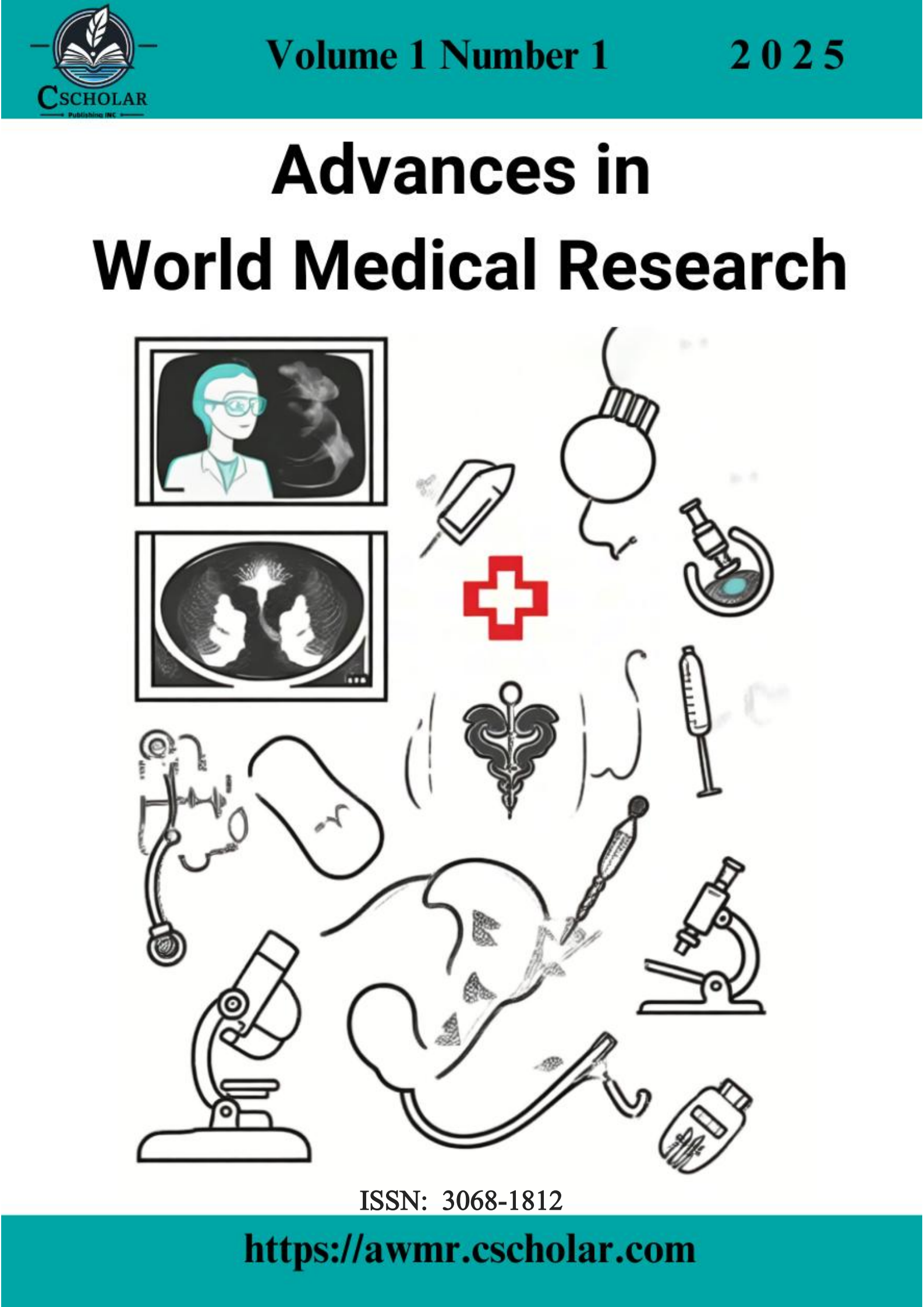Two-Sample Mendelian Randomization Analysis of the Correlation Between Allergic Rhino-Conjunctivitis and Concomitant Diseases and Peripheral Blood Eosinophil Count
DOI:
https://doi.org/10.71204/s8ksf005Keywords:
Mendelian Randomization Analysis, Allergic Rhino-Conjunctivitis, Eosinophil CountAbstract
To explore the causal relationship between allergic rhino-conjunctivitis, asthma, and eczema and peripheral blood eosinophil count from the perspective of single nucleotide polymorphisms through two-sample Mendelian randomization analysis. Five methods, including inverse variance weighting, MR-Egger regression, median weighting, simple model, and weighted model, were used to evaluate the relationship between allergic rhino-conjunctivitis, asthma, and eczema and peripheral blood eosinophil count. Sensitivity analysis (pleiotropy, heterogeneity, and leave-one-out test) was used to evaluate the robustness of the results. There was a significant causal association between SNPs of allergic rhinitis , allergic conjunctivitis, asthma, and eczema and SNPs of peripheral blood eosinophil count. The sensitivity analysis of SNP instrumental variables showed no significant heterogeneity or pleiotropy, indicating that the results are robust. Evidence shows that peripheral blood eosinophil count is associated with an increased risk of allergic rhino-conjunctivitis, asthma, and eczema.
References
Bowden, J., Davey Smith, G., & Burgess, S. (2015). Mendelian randomization with invalid instruments: effect estimation and bias detection through Egger regression. International journal of epidemiology, 44(2), 512-525.
Bowden, J., Davey Smith, G., Haycock, P. C., & Burgess, S. (2016). Consistent estimation in Mendelian randomization with some invalid instruments using a weighted median estimator. Genetic epidemiology, 40(4), 304-314.
Burgess, S., & Thompson, S. G. (2017). Interpreting findings from Mendelian randomization using the MR-Egger method. European journal of epidemiology, 32, 377-389.
Burgess, S., Bowden, J., Fall, T., Ingelsson, E., & Thompson, S. G. (2017). Sensitivity analyses for robust causal inference from Mendelian randomization analyses with multiple genetic variants. Epidemiology, 28(1), 30-42.
Cao, Z., Li, Q., Li, Y., & Wu, J. (2024). Identification of plasma protein markers of allergic disease risk: a mendelian randomization approach to proteomic analysis. BMC genomics, 25(1), 503.
Davey Smith, G., Holmes, M. V., Davies, N. M., & Ebrahim, S. (2020). Mendel’s laws, Mendelian randomization and causal inference in observational data: substantive and nomenclatural issues. European journal of epidemiology, 35(2), 99-111.
Fernandez, A., Asbell, P., & Roy, N. (2022). Emerging therapies targeting eosinophil-mediated inflammation in chronic allergic conjunctivitis. The Ocular Surface, 26, 191-196.
Gangwar, R. S., Pahima, H., Puzzovio, P. G., & Levi-Schaffer, F. (2021). Update on eosinophil interaction with mast cells: the allergic effector unit. Eosinophils: Methods and Protocols, 221-242.
Hao, Y., Yang, Y., Zhao, H., Chen, Y., Zuo, T., Zhang, Y., ... & Song, X. (2025). Multi-omics in Allergic Rhinitis: Mechanism Dissection and Precision Medicine. Clinical Reviews in Allergy & Immunology, 68(1), 19.
Hemani, G., Zheng, J., Elsworth, B., Wade, K. H., Haberland, V., Baird, D., ... & Haycock, P. C. (2018). The MR-Base platform supports systematic causal inference across the human phenome. elife, 7, e34408.
Jøhnk, C., Høst, A., Husby, S., Schoeters, G., Timmermann, C. A. G., Kyhl, H. B., ... & Jensen, T. K. (2020). Maternal phthalate exposure and asthma, rhinitis and eczema in 552 children aged 5 years; a prospective cohort study. Environmental Health, 19, 1-10.
Leonardi, A., Castegnaro, A., Valerio, A. L. G., & Lazzarini, D. (2015). Epidemiology of allergic conjunctivitis: clinical appearance and treatment patterns in a population-based study. Current opinion in allergy and clinical immunology, 15(5), 482-488.
Nguyen, L. M., Kanda, A., Kamioka, Y. (2024). Mouse eosinophil-associated ribonuclease-2 exacerbates the allergic response. Allergy,79(8), 2251-2255.
Ogawa, T., Maki, Y., Takahashi, S., Ono, T., Sato, K., Kawana, A., & Kimizuka, Y. (2025). Airway Epithelium-derived CXCL14 Promotes Eosinophil Accumulation in Allergic Airway Inflammation. American Journal of Respiratory Cell and Molecular Biology, 72(2), 39141567.
Pranavi, V., Kulkarni, K. D., & KULKARNI, K. D. (2024). Allergen Sensitivity Patterns and Their Correlation With Total Serum IgE Levels and Absolute Eosinophil Counts Among Patients With Allergic Rhinitis and Asthma in North Karnataka. Cureus, 16(8), e67183.
Slatkin, M. (2008). Linkage disequilibrium—understanding the evolutionary past and mapping the medical future. Nature Reviews Genetics, 9(6), 477-485.
Steffan, B. N., Townsend, E. A., Denlinger, L. C., & Johansson, M. W. (2024). Eosinophil-epithelial cell interactions in Asthma. International Archives of Allergy and Immunology, 185(11), 1033-1047.
Wang, M., Gong, L., Luo, Y., He, S., Zhang, X., Xie, X., ... & Feng, X. (2023). Transcriptomic analysis of asthma and allergic rhinitis reveals CST1 as a biomarker of unified airways. Frontiers in Immunology, 14, 1048195.
Weihrauch, T., Melo, R. C., Gray, N., Voehringer, D., Weller, P. F., & Raap, U. (2024). Eosinophil extracellular vesicles and DNA traps in allergic inflammation. Frontiers in Allergy, 5, 1448007.
Wu, S., Wang, Z., Zhu, Y., Zhu, X., Guo, L., Fu, Y., ... & Liu, Y. (2023). MiR-223-3p regulates the eosinophil degranulation and enhances the inflammation in allergic rhinitis by targeting FBXW7. International Immunopharmacology, 118, 110007.
Downloads
Published
Data Availability Statement
Not applicable.
Issue
Section
License
Copyright (c) 2025 Wei Zhang, Guibao Li, Jingjing Yuan (Author)

This work is licensed under a Creative Commons Attribution 4.0 International License.
All articles published in this journal are licensed under the Creative Commons Attribution 4.0 International License (CC BY 4.0). This license permits unrestricted use, distribution, and reproduction in any medium, provided the original author(s) and source are properly credited. Authors retain copyright of their work, and readers are free to copy, share, adapt, and build upon the material for any purpose, including commercial use, as long as appropriate attribution is given.




